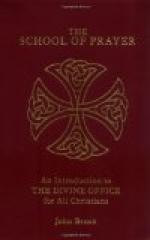There is no evidence of the abrogation of the Sabbath by Christ or by His Apostles, but St. Paul declared that its observance was not binding on Gentile converts. Accordingly, in the very early days of Christianity the Sabbath fell more and more into the background, yet not without leaving some traces behind it (see art. Sonnabender in Kraut’s Realenzyklop). Among Christians the first day of the Jewish week, the prima Sabbati, the present Sunday, was held in honour as the day of our Lord’s resurrection and was called the Lord’s Day (Apoc. i. 10; I. Cor, xvi. 2), This name, dies dominica, took the place of dies solis, formerly used in Greece and in Rome. This day has many names in the works of Christian writers. St. Ignatius, M. calls it Regina omnium dierum; St. Chrysostom, dies pacis; dies lucis; Alcuin, dies sanctus; feria prima, Baronius tells us, was another name for our Sunday.
The subject of the liturgical celebration of the Lord’s Day has been a great study and a problem to modern scholars. It appears that in the first ages of the Church, Sunday was a day of solemn reunion and of common prayer. St. Justin, in his second apology, writes that on the Lord’s Day town and country met together at an appointed place for sacrifice, for the hearing of the word of God, for pious readings and for common prayer. This common, prayer consisted largely in the recitation of the Psalms, hymns and prayers, of what are called the Sunday Office. This office was nearly always the same in psalms, in hymns and in every part; so that Sunday after Sunday, for many years, there was very little change in the Sunday united-prayer part of the liturgy, although the preaching on the incidents of the life of our Lord (Beckel, Messe und Pascha, p, 91), the blessings and the thanksgivings relieved the service from monotonous sameness.
A nocturn, a round of Psalms, was said on Saturday night by the vigilants preparing for the Sunday services. Before the eighth century two other short nocturns were added. This addition, which was copied from the monastic practice, built up the three nocturn form of office and became the model and form of the office for saints. “There is good reason for believing that originally the Divine Office formed part of the Mass. The synaxis, for which the early Christians assembled by night, consisted of the ‘breaking of bread,’ preceded by the singing of psalms and hymns, litanies and collects, readings, homilies, invocations and canticles. This was the whole official liturgical prayer, apart, of course, from private prayer” (Dom Cabrol, Day Hours of the Church, Introduction, p. xvi).
One of the chief objects of Pope Pius X. in his reform was the restoration of the liturgical importance of the Sunday office, the office of the Lord’s Day, and, therefore, in its own right, superior to the saints’ feasts by which it had been displaced from its special office, psalms and lessons. And this could only be effected by a change in the rules of occurrence, and in Title IV. (De Festorum occurentia, etc., section 2) we find the new rule for restoring Sunday offices to their proper liturgical rights.




